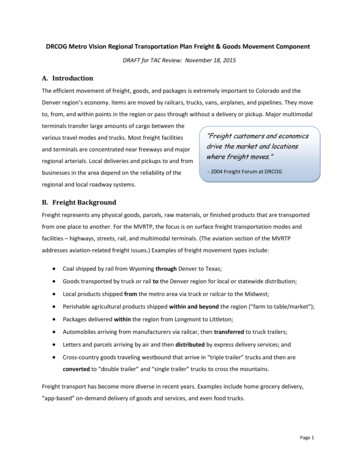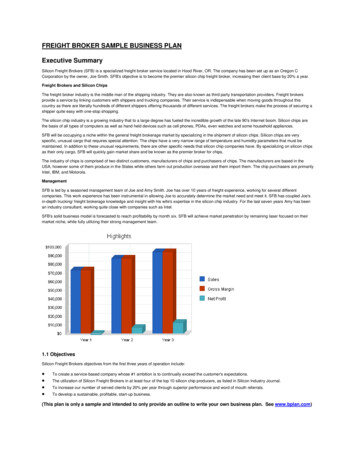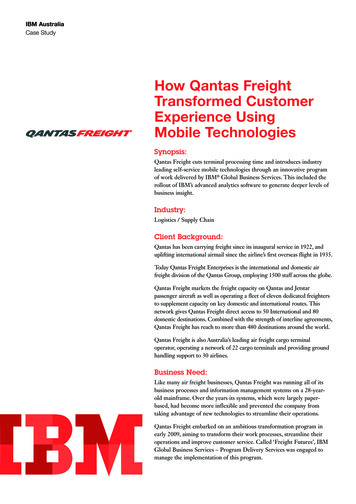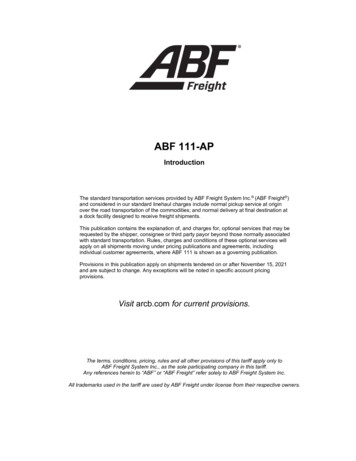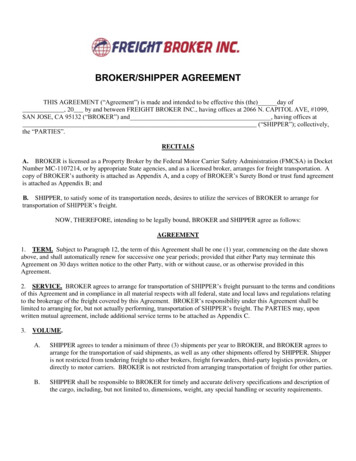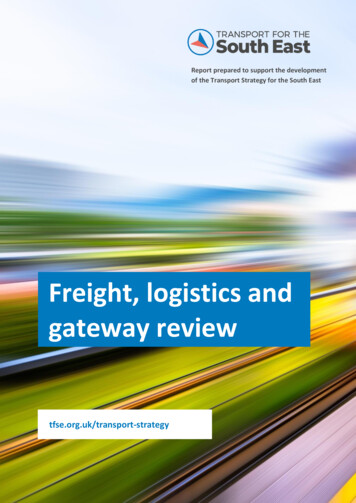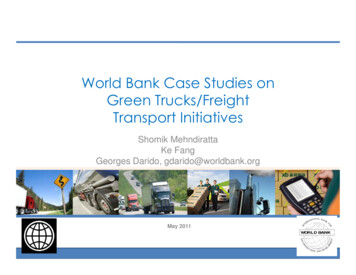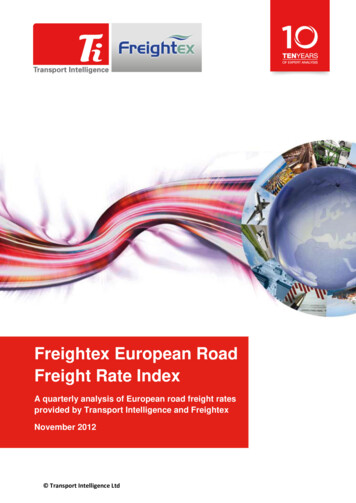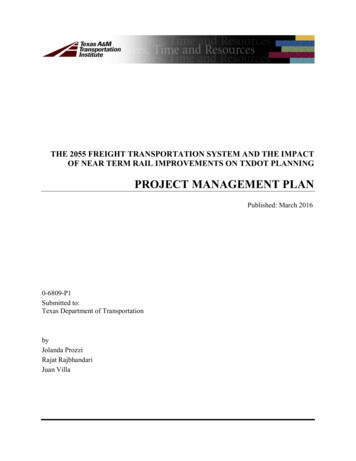
Transcription
THE 2055 FREIGHT TRANSPORTATION SYSTEM AND THE IMPACTOF NEAR TERM RAIL IMPROVEMENTS ON TXDOT PLANNINGPROJECT MANAGEMENT PLANPublished: March 20160-6809-P1Submitted to:Texas Department of TransportationbyJolanda ProzziRajat RajbhandariJuan Villa
TABLE OF CONTENTSLIST OF FIGURES . 2LIST OF TABLES . 21 INTRODUCTION . 31.1Purpose of Project Management Plan . 31.2Project Goals . 31.3Project Charter. 31.4Project Stakeholders . 31.5Change Control . 32 PROJECT ORGANIZATION . 42.1Organizational Structure . 42.2Roles and Responsibilities . 63 SCOPE MANAGEMENT PLAN . 63.1Scope Definition . 63.2Project Tasks . 7Task 1: Manage Project . 7Task 2: Engage the Texas Freight Advisory Committee . 7Task 3: Review Previous Reports and Documented Research . 8Task 4: Compilation and Analysis of U.S. and Mexican Rail Traffic Data . 9Task 5: Consult Fortune 500 and Maquila Executive Managers . 9Task 6: Analysis of Texas Rail Infrastructure and Impacts of Growing Rail TradeTraffic . 11Task 7: Host Transportation Experts Roundtable . 11Task 8: Develop TxDOT Freight Framework 2055 and Recommendations for TxDOTRail Planning Activities . 123.3Schedule . 133.4Deliverables . 154 COST MANAGEMENT. 154.1Budget . 154.2Cost Control . 165 QUALITY MANAGEMENT . 166 COMMUNICATIONS MANAGEMENT . 167 RISKS AND RISK MANAGEMENT . 168 MEASURING PROJECT SUCCESS . 179 PROCUREMENT MANAGEMENT . 171
LIST OF FIGURESFigure 1. Project Organizational Chart. . 5Figure 2. Task Schedule. . 14LIST OF TABLESTable 1. RACI Matrix of the Research Team. . 6Table 2. Task 1 Elements and Deliverables. . 7Table 3. Task 2 Elements and Deliverables. . 8Table 4. Task 3 Elements and Deliverables. . 8Table 5. Task 4 Elements and Deliverables. . 9Table 6. Task 5 Elements and Deliverables. . 10Table 7. Task 6 Elements and Deliverables. . 11Table 8. Task 7 Elements and Deliverables. . 12Table 9. Task 8 Elements and Deliverables. . 13Table 10. List of Deliverables and Due Dates. . 152
11.1INTRODUCTIONPURPOSE OF PROJECT MANAGEMENT PLANA Project Management Plan (“Plan”) defines how a project is executed, monitored,controlled, and eventually closed. The Plan defines and describes all activities underindividual tasks that need to be performed to accomplish the project. The Plan includes adetailed schedule of tasks and subtasks, and project deliverables (including necessaryreview time by all affected agencies). The Plan also identifies risks and mitigationstrategies. It describes the communication plan with the project sponsor includingsubmission of progress reports and regular team meetings to discuss outstanding issues. Itsupports timely submission of quality deliverables within budget.The intended audience of the Plan includes the project sponsor, project advisors, andresearch team members.1.2PROJECT GOALSThe Texas Department of Transportation (TxDOT) is the sponsor of the project. Theproject goals are to: (1) produce a framework for Texas’ freight transportation system in2055 and (2) develop a set of rail planning recommendations that will be beneficial toTxDOT. Specific divisions or groups that will benefit from this project include: TxDOT’sInternational Relations Office, Transportation Planning and Programming Division, RailDivision, and border and coastal districts.1.3PROJECT CHARTERJolanda Prozzi from the Texas A&M Transportation Institute (TTI) is the PrincipalInvestigator (PI) for the project. Several other researchers from TTI, including Mr. JuanCarlos Villa, and Dr. C. Michael Walton from the Center for Transportation Research(CTR), will support Ms. Prozzi.The project agreement was approved and accepted by TxDOT on June 24, 2014. Theproject termination date is June 30, 2015.1.4PROJECT STAKEHOLDERSStakeholders of the project include the project sponsor (TxDOT), especially itsTransportation Planning and Programming Division. The results of this project willcomplement the work the division is currently conducting to develop a comprehensivestatewide freight plan.In addition, the Research Technology and Implementation (RTI) Office of TxDOT willoversee the project. RTI will select a team of project advisors consisting of staff fromTxDOT and other outside agencies to guide RTI and the TTI project team throughout theduration of the project.1.5CHANGE CONTROLIn the event that changes are required in the current scope, budget, or schedule of theproject, TTI will seek approval from TxDOT for such changes before proceeding. The PIwill submit the request for changes to TxDOT. Such requests will include justification forchanges and implications on the project’s budget and schedule. In addition, TTI will track3
and monitor anticipated changes, the impact of changes on the project’s baseline, and workperformed as a result of approved changes. Any modifications to the project’s scope willrequire an amendment to the project contract.2PROJECT ORGANIZATIONTxDOT is the sponsor of the project. Kevin Pete from its RTI Office will manage theproject on behalf of TxDOT. Jolanda Prozzi from TTI is the PI for the project and willreport directly to the project manager. CTR is a collaborator on the project and will reportto the PI.2.1ORGANIZATIONAL STRUCTUREFigure 1 illustrates the organizational structure of the project team. The PI will beresponsible for all tasks performed by TTI and will be the one to coordinate with TxDOTand CTR. The PI will also be responsible for quality assurance and control of alldeliverables submitted by TTI.4
ProjectManagementJolanda ProzziNear Term RailMovementsJuan VillaFreight 2055Jolanda ProzziEngageAdvisoryCommitteeCompilation andAnalysis of U.S.and MexicanRail Traffic DataTTIReviewLiteratureTTITTICTRAnalysis ofTexas RailInfrastructureConsult Industry(Fortune 500 RFreight Framework 2055Rail Planning RecommendationsTTICTRFigure 1. Project Organizational Chart.5
2.2ROLES AND RESPONSIBILITIESThis section describes the roles and responsibilities of individual project team members. Amatrix of tasks versus roles and responsibilities of individuals is shown in Table 1. TheResponsible Accountable Consult Inform (RACI) matrix shows individuals who areresponsible (R), accountable (A), to be consulted with (C), and to be informed (I).ITask 4: Compilation and Analysisof U.S. and Mexican Rail Traffic IDataRACCRRRTask 5: Consult Fortune 500 andMaquila ExecutivesR,ARTask 6: Analysis of Texas RailInfrastructureIRATask 7: Host TransportationExperts RoundtableC,ACRTask 8: Develop TxDOT FreightFrameworkC,ACRRRWaltonC,AMeylandTask 3: Review Previous ReportsVadaliIBierlingR,AMorganTask 2: Engage the Texas FreightAdvisory sk 1: Manage ProjectTaskWarnerProzzi (PI)Table 1. RACI Matrix of the Research Team.CRRRRRRRRRR,ARCRCCCCNote: Responsible Task Doer, Accountable Buck Stops Here person, Consult Subject Matter Expert and theperson that should be in the loop, Inform Individual who needs to be informed after action has been taken.33.1SCOPE MANAGEMENT PLANSCOPE DEFINITIONFor this project, scope management will be the sole responsibility of the PI. The scope ofthis project is described in the Scope of Work statement.The PI and TxDOT will establish and approve documentation for measuring project scope,which includes timely submission of deliverables. Proposed scope changes may beinitiated by the PI, TxDOT, or any member of the TTI team.6
All change requests by the TTI team will be submitted to the PI who will then evaluate therequested scope change. Upon acceptance of the scope change request, the PI will submitthe scope change request to TxDOT for acceptance. Any scope change will require anamendment to the project contract. Upon approval of scope changes by TxDOT, the PIwill update all project documents and communicate the scope change to all stakeholders.TxDOT is responsible for acceptance of all project deliverables in accordance with theproject scope.3.2PROJECT TASKSThe project is divided into two distinct components. Component 1 (Freight 2055)comprises Tasks 1, 2, 3, 5, 7, and 8(a). Component 2 (Near Term Rail Movements)comprises Tasks 1, 4, 6, and 8(b). Following are the key tasks, as outlined in the projectScope of Work.Task 1: Manage ProjectTTI, with assistance from CTR, will develop and implement a Plan to (1) ensure that theresearch is conducted as defined in the scope within the agreed-upon time and resourcesand (2) will effectively communicate with TxDOT regarding the direction and progress ofthe project.ApproachTTI, with assistance from CTR, will develop and implement a Plan (this document), whichit will follow to manage resources efficiently during the conduct of the research (see Table2. This Plan also documents quality control and assurance procedures; feedbackopportunities; and budget and schedule management. TTI recognizes the importance ofcommunication with the TxDOT project advisors, internal and external stakeholders, andamong the team members. TTI will establish communication protocols and regularmeetings to ensure regular contact between TxDOT and the TTI research team.Table 2. Task 1 Elements and Deliverables.Work ElementDevelop Project Management PlanConduct Bi-weekly Team MeetingsDeliverable Conduct Project Kick-Off MeetingConduct Quarterly Project Progress MeetingsDevelop SharePoint SiteDevelop Monthly Progress ReportsCompletion Date08/15/2014Freight 2055 – Everyother WednesdayNear Term Rail – Everyother MondayTBD by RTITBD by RTI08/31/2014By the 3rd day after theend of the reportingperiodTask 2: Engage the Texas Freight Advisory CommitteeTTI will engage the Texas Freight Advisory Committee as an external advisory panel forthe Texas Freight 2055 component of the study.7
ApproachTTI will make two presentations to the Texas Freight Advisory Committee to (1) solicitsupport for the study and engage the committee in working with the research team inidentifying potential key contacts to be interviewed, (2) gain input in developing theinterview instrument, and (3) share the outcomes of Tasks 5 and 7 with the committee toobtain their input and insight (see Table 3).Table 3. Task 2 Elements and Deliverables.Work ElementCoordinate with the TxDOT FreightCoordinator to get on Texas FreightAdvisory Committee Meeting agendaDevelop draft ion Date04/30/2015Four weeks prior toTexas Freight AdvisoryCommittee meetingThree weeks prior toTexas Freight AdvisoryCommittee meetingOne week prior to TexasFreight AdvisoryCommittee meetingTBDShare PowerPoint presentations/handoutswith project advisors for commentDevelop final PowerPointpresentations/handoutsPresent to Texas Freight AdvisoryCommitteeSummarize input received from the TexasFreight Advisory Committee, includingpresentations (Product P2)04/30/2015 Task 3: Review Previous Reports and Documented ResearchTTI with the support of CTR will review previous reports and documented research on thefuture expectations and requirements of the transportation system by the private sector (seeTable 4).ApproachThe research team shall conduct a literature review that: Explores the changing business models of Fortune 500 companies and the maquilaindustry in Mexico. Delineates the variables/factors and assumptions that are key to companies’ changingbusiness models. Outlines potential expectations or consequences for the transportation sector.Table 4. Task 3 Elements and Deliverables.Work ElementConduct comprehensive literature reviewSummarize salient literature review findings(Technical Memorandum)Deliverable 8Completion Date10/31/201410/31/2014
Task 4: Compilation and Analysis of U.S. and Mexican Rail Traffic DataTTI will analyze various data sources to identify current and future rail traffic betweenMexico and Texas.Approach:The research team shall: Analyze multiple years of the U.S. Rail Confidential Carload Waybill Sample forTexas that will help identify trends in rail traffic between Texas and Mexico, Texasand Canada, and to and from Texas.Analyze Mexican rail data and planning information to identify trends and plans fromthe public and private sectors in Mexico and Texas that are likely to impact railmovements in Texas in the future.Table 5. Task 4 Elements and Deliverables.Work ElementAnalyze Rail Confidential Waybill Sampleand Mexican rail data, and planninginformationSummarize task findings (TechnicalMemorandum)DeliverableCompletion Date11/30/2014 11/30/2014Task 5: Consult Fortune 500 and Maquila Executive ManagersCTR with the support of TTI will consult with Fortune 500 and Maquila ExecutiveManagers regarding their envisioned freight transportation system four decades into thefuture.ApproachThe research team shall: Develop a sampling frame of (1) the Fortune 500 companies headquartered in Texasand identify key contacts, (2) Fortune 500 companies not headquartered in Texas, butreside in the U.S., and (3) major maquilas in Nuevo Laredo and Juárez. Interview a statistical sample of executive-level managers at Fortune 500 companies inTexas and out of state, as well as Mexican maquilas in Nuevo Laredo and Juárez, to getan understanding of the influencing factors, drivers, and dynamics behind theanticipated changes in their business models and operational strategies, and theassumptions, requirements, and impacts foreseen on the freight transportation system40 years in the future. Analyze the information obtained during the interviews and develop matrices showingthe influencing factors, drivers, and dynamics behind the anticipated changes inbusiness models and operational strategies, and the assumptions, requirements, andimpacts foreseen on the future freight transportation system.9
Table 6. Task 5 Elements and Deliverables.Work ElementDeliverableCategorize the 52 Fortune 500 companiesheadquartered in Texas by economic sectorto establish a sampling frame (TTI).Completion Date10/15/14Identify Fortune 500 companies to include inthe sampling that are not headquartered inTexas (CTR).10/15/14Solicit support from the National FreightAdvisory Committee members in securinginterviews with the identified companies(CTR).10/15/14Identify key contacts and scheduleinterviews with a statistical sample ofexecutive-level managers (CTR).12/31/14Identify major maquilas in Nuevo Laredoand Juárez to be interviewed (TTI).10/15/14Develop a survey instrument to conduct inperson interviews with 20 to 35 executivelevel managers at the Fortune 500 companiesin Texas and the maquilas in Mexico(CTR/TTI).11/15/14Interview the executive-level managers at theFortune 500 companies in Texas and theMexican maquilas in Juárez and NuevoLaredo (Senior CTR/TTI researchers).02/15/15Develop a survey instrument to conduct inperson interviews with 10 to 15 managers atFortune 500 companies that are notheadquartered in Texas (CTR/TTI).11/15/14Interview Fortune 500 companyrepresentatives not headquartered in Texas toget a better understanding of their locationdecisions (Senior CTR/TTI researchers).02/15/15Analyze the information obtained during theinterviews (TTI/CTR).02/28/15Develop matrices showing the influencingfactors, drivers, and dynamics behind theanticipated changes in business models, andthe assumptions, requirements, and impactsforeseen on the future freight transportationsystem (TTI/CTR).02/28/15Summarize work performed, includingcategorization of Fortune 500 companies,maquilas, preliminary interview results, andmatrix of transportation system requirements(Technical Memorandum).10 02/28/15
Task 6: Analysis of Texas Rail Infrastructure and Impacts of Growing Rail TradeTrafficTTI will lead this task that will identify and outline the major policy and planning questionsthat TxDOT and other state officials must address prior to embarking upon a majorprogram of joint planning of projects with private railroad companies to address anticipatedrail traffic impacts.ApproachThe research team shall: Locate major north-south rail corridors through the state that carry import and exporttraffic, and assess the ownership and operational characteristics and interconnections ofthese routes to the Mexican and U.S. national rail systems.Identify rail capacity issues along the corridors that would limit future rail traffic orefficiency.Identify impacts to specific locations on the rail system, such as individual highway-railintersections (at-grade crossings) or near an urban rail yard where increased trucktraffic or train-blocked crossings hamper movement on the surrounding roadways.Identify impacts on a corridor basis where rail relocation or cooperative expansion ofrail and highway facilities in another alignment will better address overalltransportation needs.Document and map known rail system capacity and constraint issues and plannedprojects to determine areas of potential planning needs.Chart urban areas where major highway traffic routes might be impeded by increasedrail traffic along import and export corridors.Document locations along the rail corridors where potential rail facility relocation forthrough rail traffic outside of the urban areas could improve both highway and railsystem mobility.Table 7. Task 6 Elements and Deliverables.Work ElementIdentify concerns and better define the policyand funding environment to developplanning recommendationsSummarize task findings (TechnicalMemorandum)DeliverableCompletion Date01/30/2015 01/30/2015Task 7: Host Transportation Experts RoundtableTTI with the support of CTR will host a transportation roundtable with recognizedtransportation professionals and modal representatives to translate the Texas FreightTransportation System envisioned by the different economic sectors into viable modalframeworks.ApproachThe research team shall host a transportation roundtable, which will take the form of a oneday workshop during which invited transportation experts and representatives from Texasports, railroads, trucking companies, pipeline operators, inland ports, border ports, andairports brainstorm on how the alternative views of the future freight transportation system11
envisioned by the different economic sectors will impact Texas’ multimodal transportationsystem and require it to change.Table 8. Task 7 Elements and Deliverables.Work ElementSolicit input from the project advisors andthe Freight Advisory Committee onparticipants for the roundtable.DeliverableCompletion Date01/31/1502/28/15Arrange all the workshop logistics, includingworkshop materials, workshop presentation,attendee sign-in sheet, and participant surveyof workshop.03/15/15Share the Task 5 technical memorandumwith invitees two (2) weeks prior to theworkshop.04/15/15Host the workshop, including the smallgroup discussions.04/30/15Extract/document common themes from thesmall group discussions and develop modalframeworks (policies, strategies,investments, and operations) required of theTexas transportation system four decadesinto the future.Summarize work performed, includingworkshop materials, workshop presentation,attendee sign-in sheet, participant survey ofworkshop, and developed modal frameworks(Technical Memorandum). 04/30/15Task 8: Develop TxDOT Freight Framework 2055 and Recommendations for TxDOTRail Planning ActivitiesTTI with the support of CTR will develop a TxDOT Freight Framework 2055 that willsupport the industry-envisioned Texas Freight Transportation System in 2055. TTI willalso develop a variety of planning options and recommendations for TxDOT rail planningactivities.ApproachThe research team shall use the results of Tasks 5 and 7 to develop a TxDOT FreightFramework 2055 that lists and discusses freight strategies, opportunities (including criticalinvestments), and constraints that will need to be overcome in moving toward the industryenvisioned Texas Freight Transportation System in 2055. TTI will also recommendprocesses and rail planning activities that can maximize future mobility options for thestate.12
Table 9. Task 8 Elements and Deliverables.Work ElementDevelop TxDOT Freight Framework 2055DeliverableCompletion Date05/31/1505/31/15Research report that documents the workperformed, methods used, and resultsachieved for all tasks performed. 06/30/15Project Summary Report that describes theproblem, the work performed, findings,measurable benefits of the project toTxDOT, lessons learned, and specificrecommendations for implementation. 06/30/15Close-Out Meeting to present the methodsand findings of the research project. Mostimportantly, the researchers will discuss animplementation plan of the findings. 06/30/15Develop planning options andrecommendations for rail planning activitiesby TxDOT (TTI).3.3SCHEDULEThe project schedule was included in the signed contract. The team will use this projectschedule, shown in Figure 2, as the baseline. Any changes to the schedule will bereviewed by TxDOT who will approve/disapprove such changes. The project advisors andTxDOT will participate in periodic reviews of the schedule.13
Form Schedule(Rev. 5/2013)(RTI)Schedule of Research ActivitiesXOriginal ScheduleCreated Date: 6/12/14Note: Each task must produce one or more deliverables. All deliverables should besubmitted to RTIMain@txdot.gov.Month After Contract ExecutionWork CompletedRRevised ScheduleResearch ActivityEstimatedCost of Task14Task 1. Manage Project (TTI)(Product P1) 10,000Task 2. Consult Freight Advisory Committee (based ontentative schedule of Committee meetings) (TTI)(Product P2) 10,000Task 3. Review Previous Reports and DocumentedResearch (TTI/CTR) 25,000Task 4. Compilation and Analysis of U.S. and MexicanRail Traffic Data (TTI) 52,133Task 5. Consult Fortune 500 and Maquila ExecutiveManagers (CTR/TTI) 150,000Task 6. Analysis of Texas Rail Infrastructure and Impactsof Growing Rail Traffic(TTI) 46,000Task 7. Host Transportation Experts Roundtable(Product P3) 50,000Task 8. Develop TxDOT Freight Framework 2055 andRecommendations for TxDOT Rail Planning Activities 147,210(TTI/CTR)Monthly Progress ReportsPlanned PMC MeetingsTechnical MemorandumsTotal TM2Figure 2. Task *M
3.4DELIVERABLESTable 10 provides a list of deliverables for this project, along with their due dates. Inaddition, the research team will produce Monthly Progress Reports by the 3rd business dayafter the reporting period. Except for the Monthly Progress Report, Final Report, and FinalProject Summary Report, all other deliverables are to be reviewed by TxDOT, who willprovide technical comments to TTI within two week of submission. The final reports needto be reviewed and sent back to TTI with comments within four weeks of submission.Table 10. List of Deliverables and Due Dates.No.4Deliverable DescriptionDue Date roject Management Plan (Task 1)August 15, 2014TTIElectronicsubmission within 45days to acquire RTIapprovalP2PowerPoint Presentation (Task 2)April 30, 2015TTICovering generalaspects and findingsof the projectP3One-Day Workshop. Workshopmaterials will include presentation,attendee sign-in sheet, and participantsurvey of workshop (Task 7)April 30, 2015TTIElectronicsubmissionR1Technical Research Report thatcompletely documents the workperformed, methods used, and resultsachievedJune 30, 2015TTIDocuments the workperformed andresults achieved forall tasks performedPSRSummary of work performed, findingsand recommendationsJune 30, 2015TTITM-1Technical Memorandum for Task 3October 31, 2014TTITM-2Technical Memorandum for Task 4November 30, 2014CTRTM-3Technical Memorandum for Task 5February 28, 2015TTITM-4Technical Memorandum for Task 6January 30, 2015TTICOST MANAGEMENTThe PI will be responsible for managing and reporting on project costs throughout theduration of the project. The PI is responsible for accounting for cost deviations andpresenting TxDOT with options for getting the project back on budget. TxDOT has theauthority to make changes to the project to bring it back within budget.4.1BUDGETThe total budget for the project is US 490,343.00 for the period starting July 1, 2014, andending June 30, 2015.15
4.2COST CONTROLAs a mechanism to control cost, TTI will create separate accounts for salary, travel, andequipment. The PI will require TTI team members to justify charges to the project.5QUALITY MANAGEMENTThe technical quality of all deliverables from this project will be ensured through review,both internal by the research team and external by the TxDOT project advisors. Thisreview will focus on identifying errors and gaps in the research approach. TTI’s editorswill review all deliverables for typographical errors, grammar, and consistent style.Ultimately, the PI will be responsible for controlling and maintaining the quality of alldeliverables to ensure the final deliverables meet TxDOT’s expectations.6COMMUNICATIONS MANAGEMENTThe PI will be solely responsible for communicating with TxDOT and the project advisors.The research team will meet bi-weekly to discuss progress of individual tasks (andactivities), risk (and opportunities), and other issues.By the 3rd day of each month, TTI will submit a monthly progress report to TxDOT forreview. The report will summarize progress on tasks during the reporting period, timespent by team members, anticipated tasks for the next reporting period, and project issuesawaiting resolution.During quarterly project progress meetings, the PI will communicate to TxDOT and theproject advisors the progress on individual tasks (and activities), risks (and opportunities),and overall performance of the project. TTI will measure progress using the scheduledeveloped and included in the signed contract. The PI will communicate with TxDOTdirectly, outside the quarterly progress meetings regarding procurement and contractualissues between TTI and TxDOT.Finally, TTI has created a Microsoft SharePoint site to share deliverables, meetingminutes, agendas, and other relevant documents with TxDOT and the project advisors.7RISKS AND RISK MANAGEMENTThe project’s success is dependent on the research team securing interviews wit
3 SCOPE MANAGEMENT PLAN 3.1 SCOPE DEFINITION For this project, scope management will be the sole responsibility of the PI. The scope of this project is described in the Scope of Work statement. The PI and TxDOT will establish and approve documentation for measuring project scope, which includes timely submission of deliverables.


